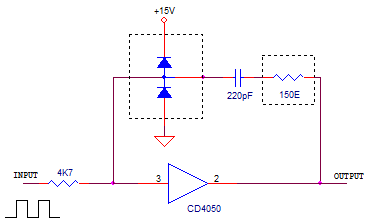Other Parts Discussed in Thread: UCC27527, CD40106B
Hi
I had asked a Q reg UCC27527 Input characteristics .
This is a related Q
We want to create a Short Pulse Suppression Ckt for our 0-15 V Signals from the DSP
Typical value would be 930 nS with guaranteed values for Min & Max .
We want to use CD4050 as per the following Ckt
Basically it Shifts the Input Pulse Train in Time Domain while killing shorter pulses .
Question is whether we need those Voltage Clamping Diodes and the current limiting Resistor ?
Thanks and regards
Varunesh



